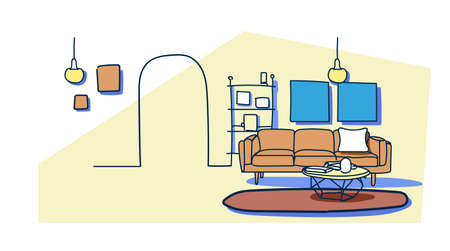1. Introduction: The Vibrancy of Indian Walls & the Role of Lighting
In every corner of India, from bustling metros to serene villages, wall colours play a pivotal role in shaping the ambience and cultural identity of homes. Traditionally, Indian households have embraced bold hues like vibrant yellows, rich reds, and serene blues, each colour resonating with deep-rooted symbolism—prosperity, energy, peace, or spiritual well-being. Wall painting is not merely an aesthetic decision but an expression of heritage and personal beliefs, often linked to festivals, regional traditions, and Vastu Shastra principles.
With evolving lifestyle trends and urbanisation, there is a rising inclination towards blending these traditional aesthetics with modern design sensibilities. One of the most significant drivers of this change is the advent of LED lighting technology. LEDs are no longer just about energy efficiency; they have become powerful tools for transforming home interiors. By strategically pairing LED lights with classic Indian wall colours, homeowners are now able to enhance the vibrancy and mood of their spaces in ways that were previously unimaginable.
This fusion of traditional wall colours and contemporary LED lighting solutions is crafting a new wave in Indian interior décor. The interplay between scientific lighting techniques and time-honoured colour palettes is enabling families to create living environments that are both rooted in culture and aligned with modern preferences. As we delve deeper into this topic, we will uncover how LEDs are redefining the visual narrative of Indian homes while preserving the vibrancy that has always been at the heart of Indian living spaces.
2. Scientific Foundations: Colour Theory Meets Indian Palettes
Understanding the dynamic interplay between colour theory and LED lighting is essential for maximising the vibrancy of Indian wall colours. In India, walls are often adorned with bold hues such as turmeric yellow, peacock blue, rani pink, and earthy terracotta. When paired with the right LED lighting, these colours can either be accentuated or subdued, depending on the scientific principles applied.
The Science Behind Light & Colour Interaction
LED technology allows for precise control over three key elements: lumens (brightness), colour temperature (warmth), and hue (tone). Each of these factors has a direct impact on how wall colours appear in Indian homes and commercial spaces:
| Lighting Element | Description | Effect on Common Indian Colours |
|---|---|---|
| Lumens | Measures brightness output; higher lumens mean more light | Makes vibrant tones pop; excessive lumens can wash out delicate pastel shades |
| Colour Temperature (Kelvin) | Ranges from warm (2700K) to cool (6500K) | Warm LEDs enhance reds, oranges, and yellows typical in Indian palettes; cool LEDs bring out blues and greens |
| Hue (CRI – Colour Rendering Index) | Reflects how accurately colours are rendered under artificial light | High CRI (80+) ensures authentic representation of intricate wall art and traditional motifs |
Popular Indian Palettes & Their Lighting Matches
For homes featuring rich ochres or vibrant marigold walls, warm white LEDs (2700–3000K) can provide a cosy, inviting atmosphere reminiscent of traditional diya lighting during Diwali. On the other hand, contemporary urban spaces with indigo or jade green accents benefit from cooler LEDs (4000–5000K), creating a crisp and modern aesthetic that appeals to the evolving tastes of Indias younger generation.
Physics in Play: Why It Matters
The interaction between photons emitted by LEDs and pigment molecules on painted surfaces determines perceived colour intensity. In regions with high sunlight exposure like Mumbai or Chennai, using LED bulbs with adjustable brightness and high CRI helps maintain colour fidelity throughout the day. This scientific approach not only enhances visual appeal but also aligns with sustainable living trends by optimising energy use.

3. Aesthetic Harmony: Enhancing Regional Indian Colours with LEDs
India’s cultural tapestry is reflected in the rich, diverse hues that adorn its walls, from the ochre yellows of Rajasthan’s palaces to the vibrant blues of Jodhpur and the earthy reds of Kerala’s heritage homes. LED lighting presents a unique opportunity to celebrate and amplify these regional identities by complementing and enhancing their traditional colour palettes. By selecting LED lights with adjustable colour temperatures and tunable brightness, homeowners and designers can create an ambience that not only respects but also elevates the inherent beauty of Indian wall colours.
The Science Behind Colour Amplification
LED technology allows for precise control over light spectrum and intensity. Warm white LEDs can bring out the depth and richness of terracotta or mustard yellow walls typical in Northern India, while cool white or bluish LEDs highlight pastel shades popular in the South. This scientific approach ensures that every pigment, shade, and undertone on the wall is accentuated, making spaces feel more lively and culturally resonant.
Rejuvenating Traditional Aesthetics
Many Indian households are rediscovering traditional wall colours inspired by local art forms such as Madhubani, Warli, or Kalamkari. With advanced LED lighting solutions, these intricate designs come to life after dusk, transforming rooms into immersive experiences. Whether you’re illuminating a Thanjavur painting or a Jaipur-inspired motif, the right LED setup can rejuvenate age-old aesthetics for contemporary living.
Tailoring Lighting for Regional Preferences
Each region in India has unique preferences shaped by climate, culture, and history. For instance, homes in Gujarat may favour brighter illumination to enhance mirror work on colourful walls, while Bengali households might opt for softer lights to complement subtle pastels. Customisable LEDs enable personalisation that celebrates India’s diversity—making every home a true reflection of its roots while ensuring modern energy efficiency.
4. Practical Implementation: LED Placement & Selection Best Practices
To truly elevate the vibrancy of Indian wall colours, it is essential to blend scientific principles with practical design strategies tailored for Indian households. Below are actionable insights on how to select and position LED lighting to harmonise with both traditional and contemporary Indian interiors.
LED Light Selection: Factors to Consider
Choosing the right LED lights is crucial for accentuating the bold and intricate colour palettes often seen in Indian homes. Prioritise LEDs with high Colour Rendering Index (CRI) to ensure wall hues appear authentic and lively. Warm white LEDs (2700K-3000K) typically complement earthy tones like terracotta, mustard, or ochre, while cool whites (4000K-6000K) enhance blues, greens, and modern minimalist palettes.
| Wall Colour Palette | Recommended LED Type | Suggested CRI |
|---|---|---|
| Warm/Earthy Tones (Terracotta, Maroon) | Warm White LED (2700K-3000K) | >90 |
| Cool/Modern Tones (Sky Blue, Mint Green) | Cool White LED (4000K-6000K) | >90 |
| Accent Walls (Gold, Royal Blue) | Dimmable RGB LED Strips | >85 |
Placement Strategies: Adapting to Indian Household Layouts
The placement of LEDs must consider the layout and functional zones typical of Indian homes:
- Living Room: Use recessed ceiling LEDs for general illumination. Highlight accent walls or art pieces with adjustable spotlights. Cove lighting along false ceilings offers a soft, luxurious glow for festive gatherings.
- Pooja Room: Opt for soft warm LEDs placed above or behind idols to create a serene ambience without harsh shadows.
- Kitchen & Dining: Task lighting under cabinets ensures practical visibility. Pendant lights over dining tables add a decorative touch that matches colourful walls or tile backsplashes.
- Bedrooms: Wall-mounted sconces or indirect cove lights help create a cosy retreat. Dimmable LEDs allow for mood adjustments suitable for relaxation or reading.
Key Techniques for Optimal Impact
- Layered Lighting: Combine ambient, accent, and task lighting for dynamic effects that highlight both colour and décor.
- Avoid Glare: Position LEDs to prevent direct glare on glossy paint finishes or textured walls common in Indian homes.
- Cultural Adaptation: Integrate traditional elements such as jharokha frames or hand-painted murals with concealed strip lighting to honour heritage while embracing modern technology.
- Dimming Controls: Use dimmers to adjust brightness during festivals, family events, or quiet evenings—enhancing both functionality and aesthetics.
Conclusion of Best Practices
The synergy between thoughtfully chosen LEDs and traditional Indian colour schemes can transform any living space into a vibrant yet harmonious environment. By considering the unique needs of Indian households—spanning cultural practices, spatial layouts, and lifestyle preferences—homeowners can achieve both visual appeal and daily comfort through strategic LED implementation.
5. Market Trends: The Rise of Smart & Energy-Efficient Lighting in India
Indias lighting market is undergoing a significant transformation, driven by evolving consumer expectations, technological advancements, and a growing emphasis on sustainability. As Indian homeowners and designers seek to enhance wall colours with optimal illumination, the adoption of smart and energy-efficient LED solutions is becoming the norm. Affordability plays a crucial role in purchase decisions, with consumers actively comparing cost, longevity, and energy savings when selecting lighting options for their homes. Government initiatives promoting energy conservation and the widespread availability of affordable LED products have further accelerated this shift.
Affordability Meets Innovation
With India’s price-sensitive market, brands are introducing a diverse range of LED lighting products catering to different budgets without compromising on quality or aesthetics. Bulk purchases, government subsidies, and local manufacturing have made LEDs accessible to urban and semi-urban households alike. This affordability has empowered more Indians to experiment with lighting that complements their wall colours—be it vibrant traditional hues or modern minimalist shades.
Sustainability as a Key Driver
Environmental consciousness among Indian consumers is on the rise. People now prefer lighting solutions that offer lower electricity consumption and longer lifespans. The integration of smart controls—such as dimmers and motion sensors—not only enhances user convenience but also supports sustainable living by reducing unnecessary power usage. These trends align perfectly with India’s broader push towards green technologies and responsible consumption.
Changing Decorative Preferences & Consumer Behaviour
The aesthetic value of lighting is no longer overlooked. Indian households are increasingly aware of how the right LED temperature and colour rendering can highlight intricate wall textures, traditional motifs, or bold accent walls. Decorative LEDs—like strip lights, spotlights, and tunable white fixtures—are being used creatively to set moods for festivals, gatherings, or day-to-day living. Furthermore, the younger generation is actively seeking customisable smart lighting systems controllable via smartphones or voice assistants, reflecting a blend of cultural appreciation and modern lifestyle aspirations.
In conclusion, the Indian lighting market’s rapid evolution towards smart, energy-efficient LEDs is closely intertwined with local decorative preferences, economic considerations, and sustainable values. As consumers become more informed about how light interacts with colour and space, brands that offer innovative yet affordable solutions will continue to shape the future of interior aesthetics across India.
6. Conclusion: The Future of Indian Interiors through Light & Colour
Summing Up Key Learnings
The interplay between LED lighting and traditional Indian wall colours is unlocking new possibilities for interior spaces across the country. As we have explored, the scientific rationale behind colour and light synergy is deeply rooted in both aesthetic appeal and psychological well-being. By understanding how warm, cool, or dynamic LEDs interact with hues like turmeric yellow, royal blue, and earthy terracotta, homeowners and professionals can craft truly immersive environments that resonate with India’s rich cultural heritage.
Guidance for Homeowners
If you are planning to renovate your home or simply refresh a living area, start by considering the mood you wish to evoke. For instance, pairing soft white LEDs with pastel shades creates a serene vibe ideal for bedrooms, while vibrant coloured walls can be accentuated with focused LED spotlights in living rooms or puja spaces. Experimentation is key—don’t hesitate to try different light temperatures and intensities before finalising your set-up.
Recommendations for Designers
For interior designers seeking to deliver contemporary yet culturally rooted solutions, integrating smart LED technology allows for greater flexibility and personalisation. Dynamic lighting schemes that adapt to time of day or function can bring out the best in Indian palettes. Collaborate closely with paint suppliers and lighting vendors to ensure compatibility and maximise visual impact. Remember, modern Indian clients increasingly value both energy efficiency and style.
Industry Insights for Stakeholders
Manufacturers, retailers, and industry players should note the growing demand for LED products tailored specifically for Indian interiors. Developing user-friendly lighting systems that highlight traditional colours while meeting modern sustainability standards will be key to market leadership. Partnerships between paint brands and LED manufacturers can yield innovative offerings designed for local preferences—from festival-ready settings to wellness-centric ambiences.
The Road Ahead: Innovation Meets Tradition
The future of Indian interiors lies in embracing innovation without losing sight of our unique cultural context. By thoughtfully combining cutting-edge LED lighting with classic wall colours, all stakeholders—homeowners, designers, and industry leaders—can contribute to a new era of beautiful, functional, and sustainable living spaces across India.

